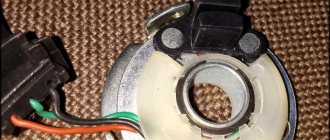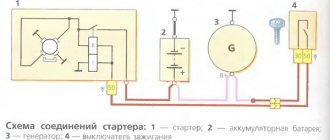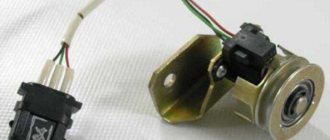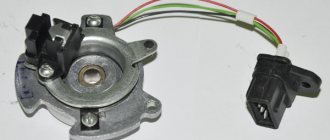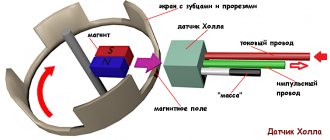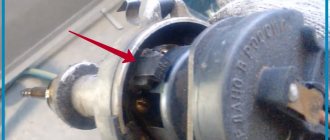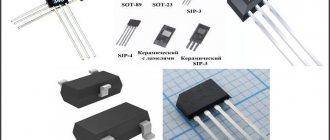If you were unable to start your car and after checking the spark on the spark plug, it turned out that there was simply no spark, then you should check the entire ignition system of the VAZ 2106 and find a malfunction of a specific element.
In personal practice, I have had several cases that were accompanied by loss of spark. And then I will give them and talk about each in more detail.
Again, I will make a reservation that this is not a complete list of all the problems that can cause it, but I will try to list most of them. For experienced owners, you can supplement your thoughts by
One of the spark plugs is faulty
If, when checking a spark plug, a spark does not appear between the electrodes, then the first thing to do is check the spark plug itself. It is possible that this was the cause of this problem. Take a working spark plug (it’s better to always carry a spare one with you) and crank it a little with the starter. Observe the performance of the candle. If a spark appears, great; if not, you should look for the cause further. Also, you can see the problems that cause the spark to disappear here: https://atlib.ru/blog/164-net-iskry
Failure of high-voltage spark plug wires or the central wire of the ignition coil
If there is no spark on any one cylinder, then try swapping the high-voltage wires. When after this the operation of the previous cylinder was restored, but the other cylinder, on the contrary, stopped working, this indicates a failure of the spark plug wire.
If a spark does not reach any of the VAZ 2106 spark plugs, then you should check the integrity and functionality of the central wire. This can be done in a similar way as I wrote in the last paragraph. Also, you should just try to stick the wire harder into the coil and the distributor cover. Perhaps the wire has just jumped out a little in one of these places and there is no necessary contact.
Peculiarities
The operation of the Niva 21213 system depends on the condition of its parts. High-voltage wires must have a distributed resistance, the value of which is in a certain range. Too much resistance will result in the ignition coil not having enough power to cause a breakdown. Low resistance increases interference. Although, some install just such wires. Of course, the spark power will increase and engine performance will improve. Spark plugs can lose their properties over time. The electrodes melt and carbon deposits appear.
The high temperature inside the cylinders greatly heats the spark plugs. Therefore, even when the ignition is turned off, ignition occurs from heated spark plugs.
It is important that all spark plugs have the correct gap between the electrodes. This will ensure high-quality ignition of the mixture. The distributor cover must be clean from dirt, since its presence can lead to current leakage.
Failure of the switch or hall sensor and no spark
This item applies to owners of a VAZ 2106 with electronic ignition. If there is no spark, then these two elements can cause this disaster. It is necessary to diagnose the malfunction of these parts and replace them with new ones if necessary.
If you have a BSC installed on your VAZ 2106, then you can carry a hall sensor with you as a spare. Which, in fact, is the most common cause of malfunction. Or, as a last resort, do like me. Carefully fold the old contact ignition kit and let it lie in the trunk. It doesn't take up much space, but it can help you out a lot somewhere on the road. For example, if one of the BSZ elements burns out!
If any of the owners have encountered other reasons for the disappearance of the spark, then please share in the comments. I think that for many owners this information will be very useful!
VAZ 21213 no spark on the center wire
Part two - the engine starts, but does not run satisfactorily.
Necessary preconditions: 1) the engine is in good working order; 2) the marks of the crankshaft and camshaft match; 3) gasoline and air enter the suction manifold from the carburetor; 4) there are no barriers to the escape of exhaust gases (no one’s “kind hand” stuck a potato into the muffler);
Step one: check for spark from the ignition coil. How to check it alone: 1. Gearbox in neutral; 2. pull out the central wire from the distributor and fix the metal tip of this wire at a distance of 5-7 mm from the ground (it is convenient to squeeze the insulating cap between the brake cylinder and the outlet tube); 3. turn on the ignition; 4. remove the block with wires from the starter relay and short-circuit the thick wires in it (perpendicular to each other) with a jumper - the starter will work; At this moment, a spark will (should) begin to beat rhythmically from the main wire. If there is no spark at all, read step two. If the spark is weak and begins to skip with a slight increase in the air gap (up to 10-12mm), read step six. In passing, I note that an indicator of the reliability of a starting spark is its continuity and length (and not color and thickness).
No spark on VAZ 2106
Sparking is an important process that ensures the startup and stable operation of the power unit, for which the ignition system is responsible. The latter can be contact or non-contact, but the essence of its work remains the same - to ensure the formation and distribution of a spark to the desired cylinder at a certain point in time. If this does not happen, the engine may either not start at all or run intermittently. Therefore, it is worth dwelling in more detail on what kind of spark there should be and what the reasons for its absence may be.
DH regulator
The DH regulator is undoubtedly considered one of the most important components of the ignition distributor. Located near the distributor shaft, on which a magnetically conductive plate is fixed, which looks like a crown, it performs controlling functions.
Hall sensor operation diagram
The DH plate or curtain has the same number of slots as there are cylinders in the car engine. Another important element of the DC is a permanent magnet.
To better understand the principle of operation of the DC, it is recommended to pay attention to the operating diagram of the shaft. When it rotates, its plates alternately pass through the curtain holes in the DH. Thus, an impulse is generated, which is supplied through the commutator to the ignition coil. The latter, as you know, acts as a voltage converter. The low voltage current in the coil is converted into high voltage current and supplied to the spark plugs.
The DC itself has three outputs or terminals, as experts also call them. One of the terminals is connected directly to the minus (ground), the second is a plus with a voltage of 6 V, and finally, the third is used to supply the converted pulse to the switch.
Troubleshooting
Troubleshooting in the ignition system of the VAZ “Six” should be carried out using the method of elimination, checking element by element sequentially. This is worth dwelling on in more detail.
Battery check
Since when starting a car, the power source is the battery, it is by checking this device that diagnostics should begin. Malfunctions with the battery appear when you try to start the engine. At this moment, the indicator lights on the instrument panel go out. The reason could be either poor contact on the terminals themselves, or simply a weak battery charge. Therefore, the condition of the terminals should be checked and, if you need to clean them, tighten the fastening. To prevent future oxidation, it is recommended to cover the contacts with a graphite coating. If the battery is discharged, it is charged using an appropriate device.
Spark plug wires
The next elements that require mandatory checking in case of problems with sparking are explosive wires. Upon external inspection, the cables should not show any damage (cracks, breaks, etc.). To assess whether a spark passes through the wire or not, you will need to remove the tip from the spark plug and place it near a ground (5–8 mm), for example, near the engine block, and crank the starter for a few seconds.
At this time, a powerful spark should jump. The absence of one will indicate the need to check the high-voltage coil. Since it is impossible to determine by ear which of the cylinders does not spark, the test should be performed one by one with all wires.
Video: diagnostics of explosive wires with a multimeter
Spark plug
Spark plugs, although infrequently, still fail. If a malfunction occurs, it is with one element, and not with all of them at once. If a spark is present on the spark plug wires, then to check the spark plugs themselves, they are unscrewed from the cylinder head of the “six” and an explosive cable is put on. The metal body of the spark plug touches the masses and turns the starter. If the spark plug element is working, then a spark will jump between the electrodes. However, it may also be absent from a working spark plug when the electrodes are filled with fuel.
Fuel level
The Niva Chevrolet fuel level sensor determines the remaining fuel in the tank and transmits the readings to the dashboard. It is located in the fuel tank. Its breakdown can lead to the car stopping at the most inopportune moment, so the driver will not know how much fuel is actually in the tank. Therefore, if there are problems with it, it is better to replace it as soon as possible, this can be done like this:
- The right side of the rear seat rises
- A fluffy rag is folded back
- Unscrew two screws on the fuel pump hatch
- Removing the hatch
- Disconnect the two pipes and terminals
- Unscrew 8 screws
- Carefully remove the fuel pump and replace the required element
All work is done within 10 minutes.
Checking the contact distributor
The need to check the distributor-breaker arises if problems arise with sparking, but during the diagnostics of the ignition system elements the problem could not be identified.
Cover and rotor
First of all, we inspect the cover and rotor of the device. The check consists of the following steps:
- We dismantle the distributor cover and inspect it inside and out. There should be no cracks, chips, or burnt contacts on it. If damage is found, the part must be replaced.
contact Group
The main malfunctions of the ignition distributor contact group are burnt contacts and incorrect clearance between them. In case of burning, the contacts are cleaned with fine sandpaper. If they are severely damaged, it is better to replace them. As for the gap itself, to check it it is necessary to remove the cover of the distributor-breaker and turn the engine crankshaft so that the cam on the distributor shaft opens the contacts as much as possible. We check the gap with a feeler gauge and if it differs from the norm, then we adjust the contacts by unscrewing the corresponding screws and moving the contact plate.
Capacitor
If a capacitor is installed on the distributor of your “six”, then sometimes the part can fail as a result of a breakdown. The malfunction appears as follows:
- problems starting the engine;
- sudden engine stop while driving.
You can check an element in the following ways:
- Control lamp. Disconnect the wiring coming from the coil and the capacitor wire from the distributor according to the figure. We connect a light bulb to the open circuit and turn on the ignition. If the lamp lights up, it means that the part being tested is broken and requires replacement. If not, then it's OK.
Removing the distributor from a VAZ-2107 car
In order to repair the distributor yourself, you need to understand its structure and the purpose of all its parts. The operating algorithm of the mechanical distributor is as follows:
- The rotating roller periodically presses the cam onto the spring-loaded movable contact, as a result of which the low voltage circuit is broken.
The gap between the contacts appears as a result of pressing the cam on the spring-loaded pusher
In the old version, the unit was equipped with a manual octane corrector (item 4)
In fact, 2 electrical circuits pass through the distributor - low and high voltage. The first is periodically broken by the contact group, the second is switched to the combustion chambers of different cylinders.
In a contactless distributor, the main role is played by a magnetic sensor that sends signals to the switch
Checking the contactless distributor
If the “six” is equipped with a contactless ignition system, then checking elements such as spark plugs, coil, and explosive wires is performed in the same way as with a contact one. The differences lie in checking the switch and the Hall sensor installed instead of the contacts.
Hall Sensor
The easiest way to diagnose a Hall sensor is to install a known working element. But since the part may not always be at hand, you have to look for other possible options.
Checking the removed sensor
During the test, the voltage at the sensor output is determined. We determine the serviceability of the element removed from the machine according to the presented diagram by applying a voltage in the range of 8–14 V.
By placing a screwdriver in the gap of the sensor, the voltage should change within 0.3–4 V. If the distributor has been completely removed, then by turning its shaft, we measure the voltage in the same way.
Checking the sensor without removing it
The performance of the Hall sensor can be assessed without removing the part from the car, using the diagram provided.
The essence of the test comes down to connecting a voltmeter to the corresponding contacts on the sensor connector. After this, turn on the ignition and turn the crankshaft with a special key. The presence of voltage at the output, which corresponds to the above values, will indicate the serviceability of the element.
Video: Hall sensor diagnostics
Switch
Since the formation of a spark also depends on the switch, you need to know how to check this device too.
You can purchase a new part or perform the following sequence of actions using a control light:
- Unscrew the nut and remove the brown wire from contact “K” of the coil.
- We connect a light bulb to the resulting open circuit.
- Turn on the ignition and crank the starter several times. If the switch is working properly, the light will light up. Otherwise, the element being diagnosed will need to be replaced.
Video: checking the ignition system switch
The performance of the systems and components of the VAZ “six” must be constantly monitored. The occurrence of problems with sparking will not go unnoticed. Troubleshooting and troubleshooting does not require special tools or skills. A minimal set consisting of keys, a screwdriver and a light bulb will be quite sufficient for diagnostics and repairs. The main thing is to know and understand how a spark is formed, and what elements of the ignition system can affect its absence or poor quality.


